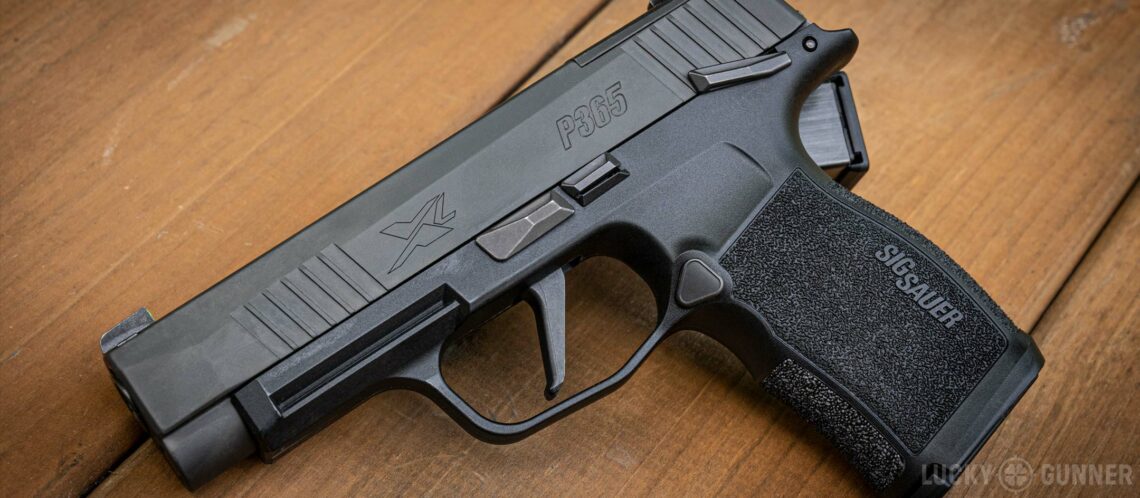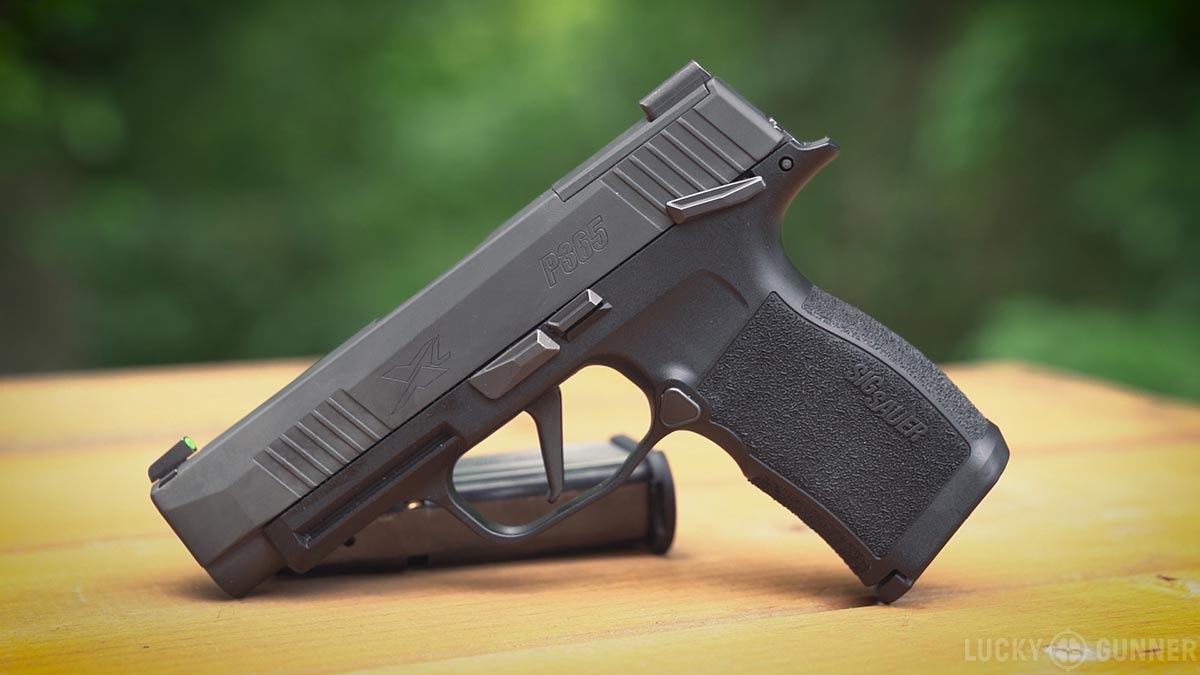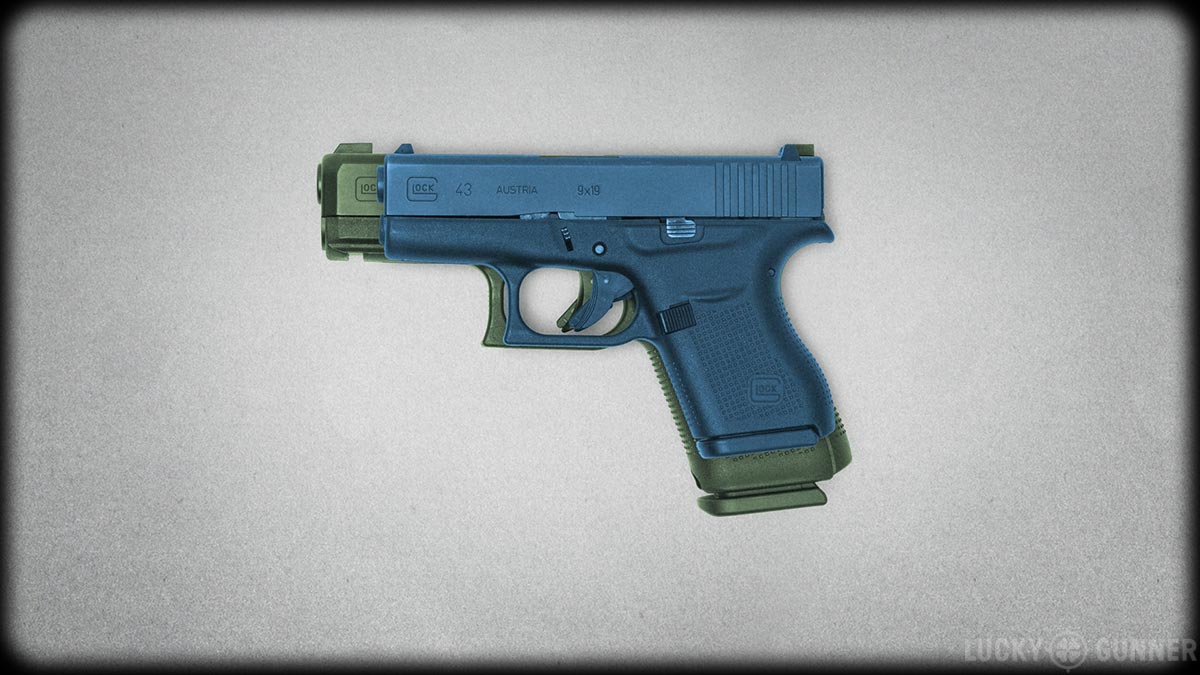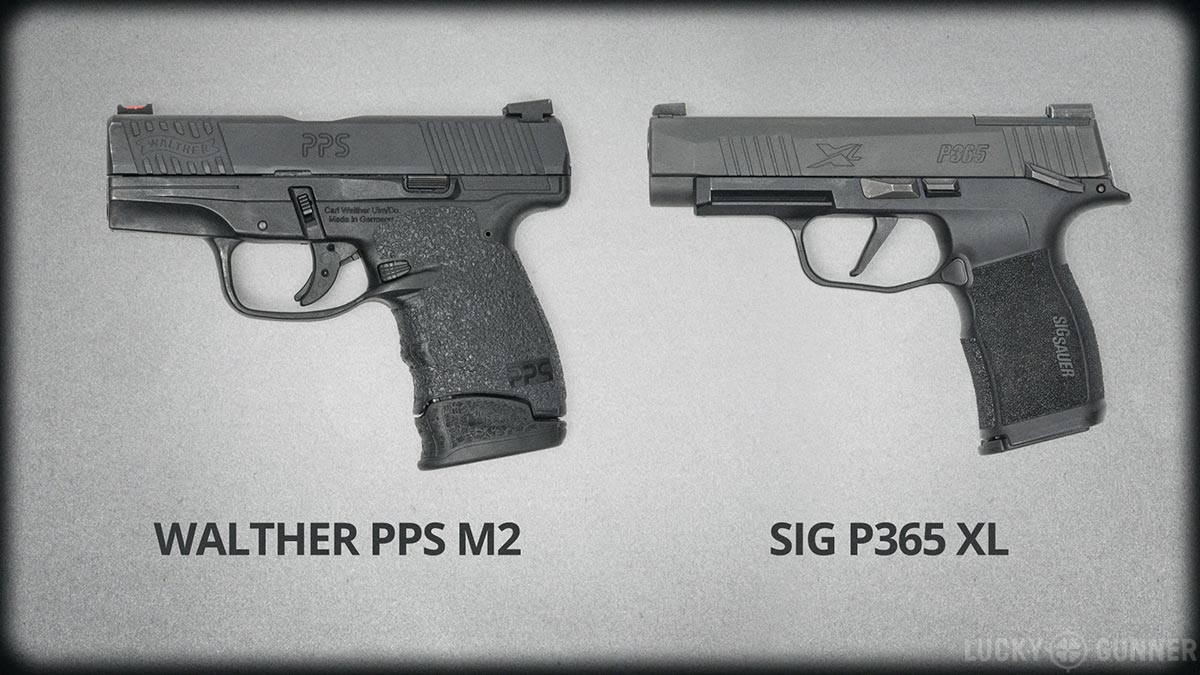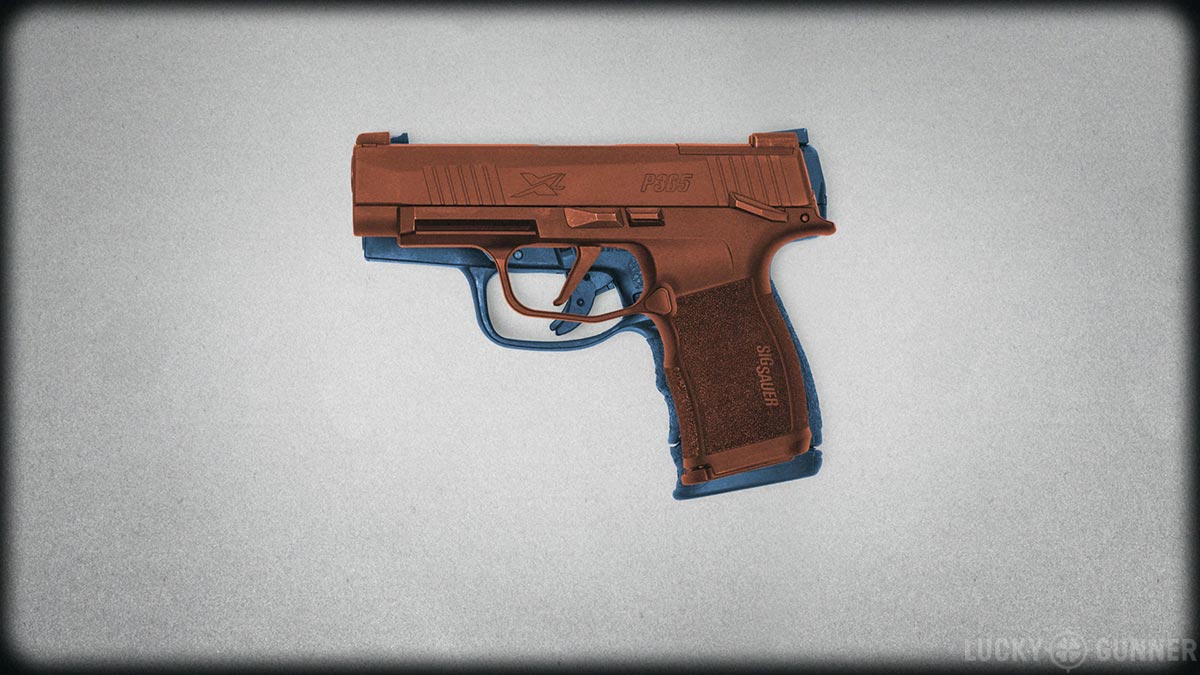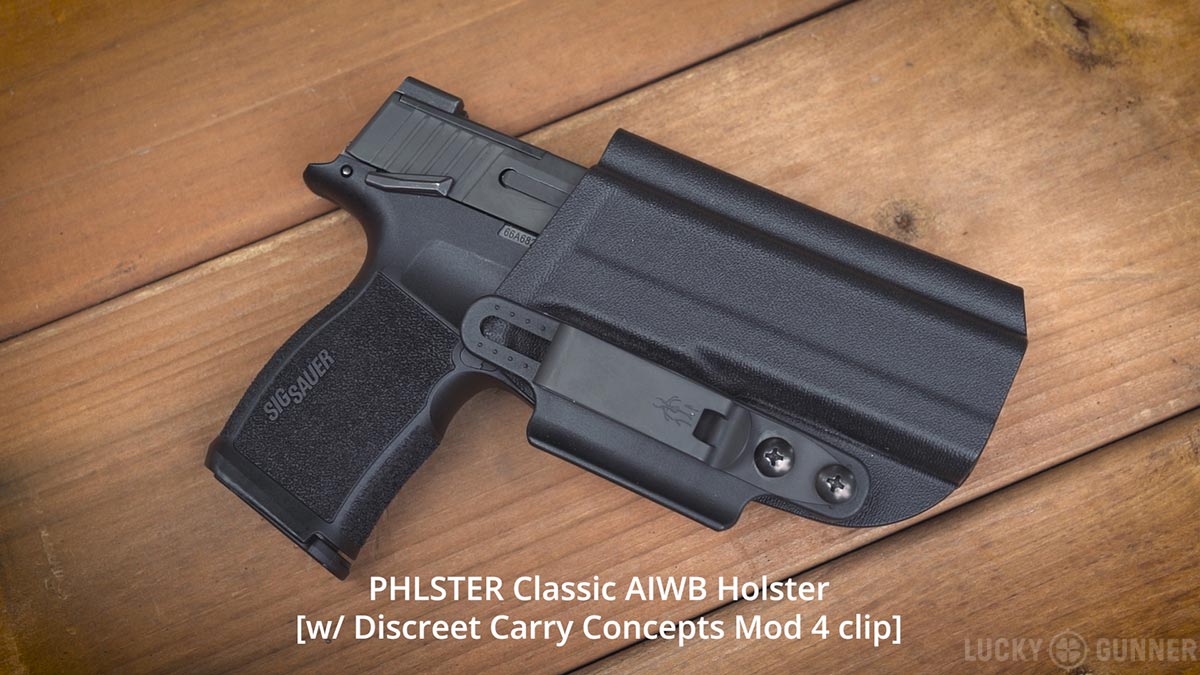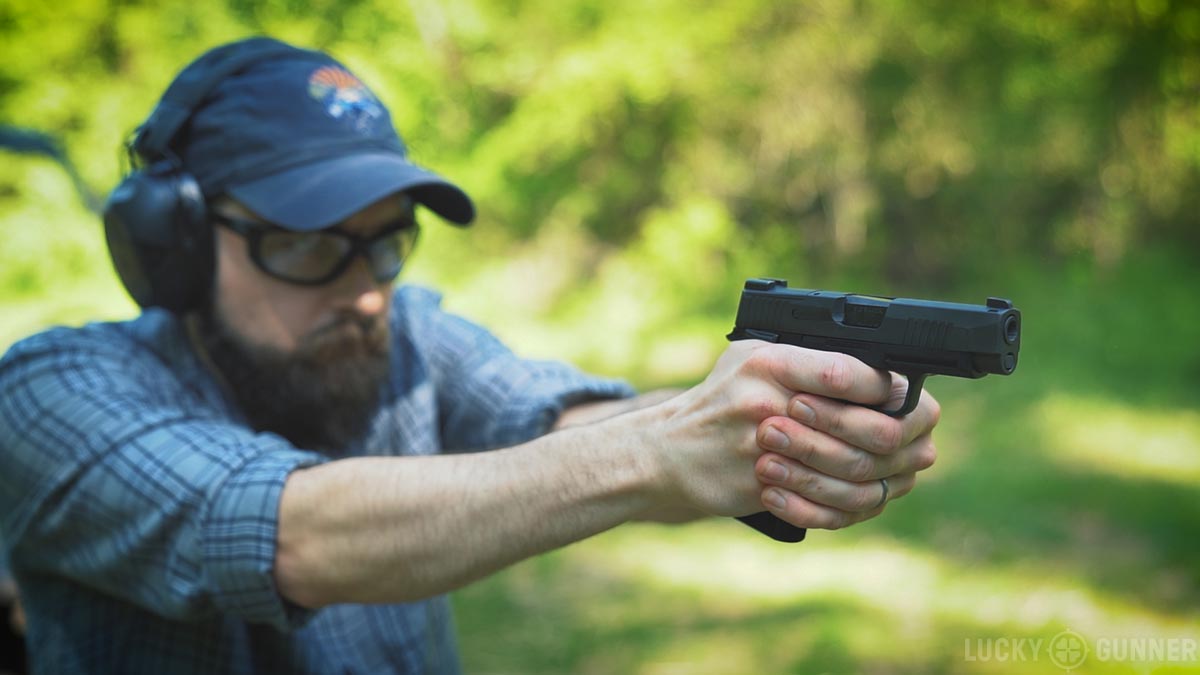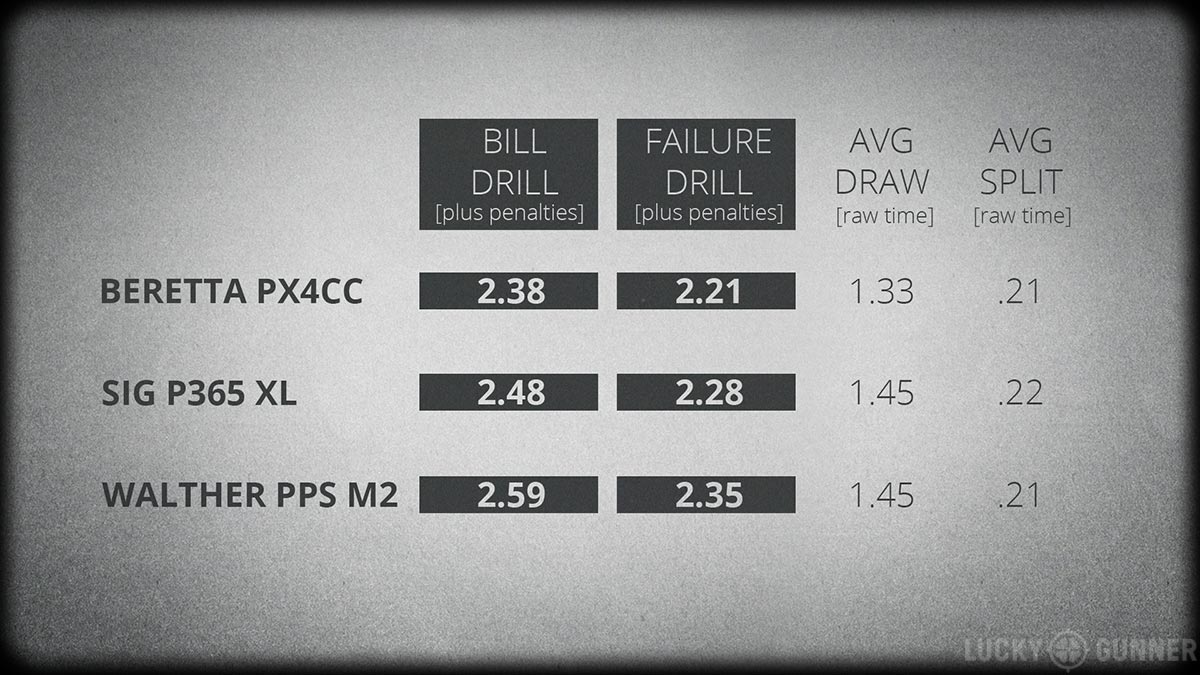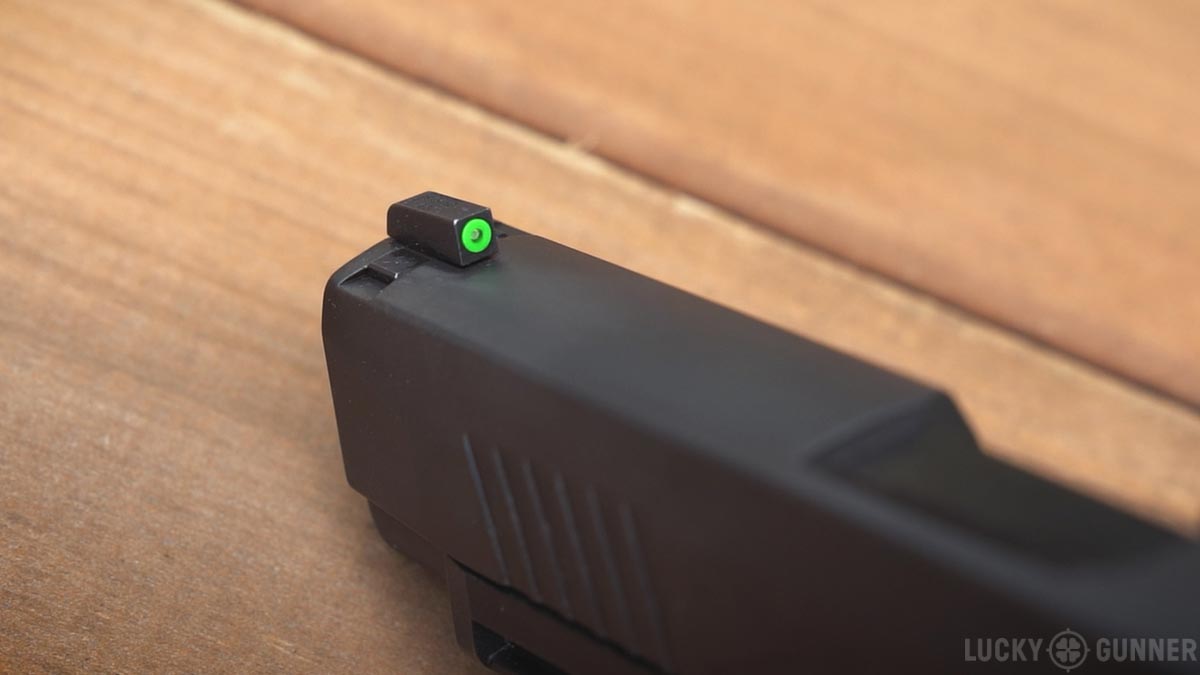For a guy who loves DA/SA autos and snubby revolvers, the Sig P365 XL probably seems like an odd choice. But I can’t deny that this is an awesome carry gun. In this review, I’m looking at what I’ve learned to like about the P365 XL after 2000 rounds and a couple of things that could use some improvement.
Get all the details in the video below, or scroll down to read the full transcript.
The Sig Sauer P365 XL is easily the most impressive new handgun I’ve tried in a long time. Today, I want to talk about why it is rapidly becoming one of my favorite options for concealed carry.
This gun falls into a whole new category of concealable semi-autos. They aren’t single stack and they’re not really double stack either. They’re somewhere in between.
Background
Let’s go back to the 1990s — the heyday of the double stack wondernine. At that time, a compact handgun was basically a full size double stack pistol with the grip chopped down and the slide and barrel shortened a little bit. For a sub-compact, they just shortened everything a little more. We can see perfect examples of this in a couple of the most popular autos of the time; the compact Glock 19 and the subcompact Glock 26. When all the other gun companies started cranking out their own polymer pistols in the early 2000s, they followed the same basic template.
Then a few years ago, the polymer single stack 9mms came along and shook things up. In 2012, the Smith & Wesson Shield wasn’t the first, but it was the gun that brought the single stack nine out of a niche status to become one of the most common types of carry gun in the country. Since then, we have seen dozens of new polymer single stack 9mm pistols come from every corner of the industry. And now we’re all sick of them. Especially those of us who have to evaluate and review these things for a living.
In January of 2018, Sig Sauer rescued us from this endless tedium with something that was actually a little bit different: the P365. It looks like a single stack nine. It’s the same size as a single stack nine. But, they somehow managed to cram ten rounds into this little clown car of a magazine. The typical single stack 9mm magazine holds 6 to 8 rounds, but this is not quite a single stack magazine. The top three or four rounds in the magazine are more or less stacked right on top of each other, but then the mag tapers outward and at the bottom, the rounds are staggered like a double-stack.
The gun was a big hit. It won all kinds of awards. There were some reliability issues early on, but the worst of those seem to have been worked out after the first year or so. In May of last year, Sig released a version with a frame-mounted, ambidextrous manual safety. And then last July they rolled out this version: the Sig P365 XL.
The Sig P365 XL
It’s got the same slim profile as the original P365 but with a longer barrel and a slightly longer grip for flush-fitting 12-round magazines. Sig also makes an extended 15-round magazine. It’s about 3 ounces heavier than the standard P365 at 26.3 ounces loaded. Most of that additional weight comes from the longer slide and barrel which is 3.7 inches instead of 3.1. It is available with or without a manual safety — this one has the safety. It has the XSeries straight trigger — that’s only available as an aftermarket upgrade for the original P365 but it’s standard on the XL. And it also has, as standard, a set of Sig X-RAY3 night sights and a slide that’s machined to accept a micro red dot optic.

It’s worth asking why I’ve taken an interest in this particular gun, or the P365 in general. I’m content to carry around a snub nose revolver most of the time. A glorified single stack with a couple of extra rounds in the mag doesn’t do much for me. If I’m going to seriously consider a carry gun for my own personal use, it has to be very easy to shoot, very easy to carry, and it has to meet my personal standards for safety. I’ll get back to those first two in a minute. Let me get the safety thing out of the way first. Or maybe “risk management” is a better term.
Why Choose the Manual Safety Version?
If you’ve been watching my videos for a while, then you know that for semi-autos, I typically prefer hammer-fired guns, whether they’re double action only or double action/single action. I like to have the ability to pin the hammer with my thumb so it’s physically impossible for the gun to fire while it’s being reholstered. The Striker Control Device that’s available for Glocks is the next best option. It does the same thing as a hammer when you’re reholstering. A manual safety is a distant third option, but depending on how it’s designed, I’ll consider it for a carry gun.
I don’t think safeties are for everybody. I’m especially reluctant to recommend a manual safety for a novice shooter, or for anyone who doesn’t practice fairly regularly. But I’m going to be drawing and reholstering a carry gun thousands and thousands of times, both in dry practice and at the range. Every reholster has the potential to turn into a catastrophic accident. All it takes is one distraction — one momentary lapse in attention.
So in addition to following all of the best practices for safe gun handling and safe reholstering, I like there to be at least one extra layer of mechanical safety to help mitigate risk. I especially like it if that extra layer doesn’t compromise the usability of the gun. Whether this manual safety does that or not is debatable.
I’m about to pour a lot of love all over this gun and talk about how amazing it is. But this manual safety is not good. It’s also not horrible. It’s not like the miserable little nub of a safety you’ll find as an option on the Smith & Wesson Shield. And it’s not as bad as that weird safety on the LCP .22 LR I talked about a couple of weeks ago. It has a very positive click on and off and it’s ambidextrous. It could still be much better. It’s not wide enough and it needs to be positioned about a quarter inch farther forward on the frame.
I don’t know why gun companies keep screwing this up. I think it’s further evidence that the people who are making these design decisions don’t actually shoot the guns. There are plenty of examples of good manual safeties out there, so there’s not really any excuse for not knowing what one should look like.
I’ve mentioned the safety on the M&P 22 Compact before. This is an excellent safety. It’s not big at all, but it’s wide enough that you can rest your thumb on it while you’re shooting. When you grasp the gun, the knuckle of the thumb naturally comes down on top of the safety to disengage it. You can’t miss it. The P365 safety is just barely big enough to be usable, and just small enough that I’ll miss it on the first try every once in a while. And if I rest my thumb on it, this sharp edge on the rear rubs against my thumb when the gun recoils.
At first, that was just annoying, but on a long range session, it will actually cut my thumb open. Right now, I’ve got a nice little blood blister there that’s under the scar tissue from the first couple of times it happened. Honestly, I could live with that if the safety was just wider and easier to disengage. Sig, please take some of that sweet, sweet cash from charging 50 bucks each for these magazines and give it to your R&D team so they can fix this safety.
Okay, now I can talk about all the good stuff.
Sig P365 XL Size Comparison
The appeal of the Sig P365 XL is not simply that it is small and therefore easy to carry. A lot of pistols are small. This gun is small and shootable. And it’s small in a different way than other pistols. Let’s look at some size comparisons so I can show you what I mean.
Here on the right we have the world’s most ubiquitous compact 9mm, the Glock 19. On the left is Glock’s single stack 9mm, the Glock 43. It’s not the smallest 9mm out there, but I think it’s among the smallest nines that are still reasonably shootable.
I’m going to overlay these two and align them by the grip tang. That’s the highest part of the grip where the web of your hand would go. Obviously, the 43 has a shorter slide and grip and the trigger reach is also a bit shorter.
If we look at them from the back, the 43 is significantly slimmer. I measured the widest part of the grip, not including the magazine well and it’s .81 inches for the 43 and 1.31 inches for the 19.
Now let’s throw the P365 XL in there. Just as you might expect, it’s right in between the two. Maybe a little closer to the 43 with a grip that’s just 1 inch thick. But let’s go back to the side view.
Again, the Sig is right in the middle in terms of slide length and grip height. But check this out; look at how much shorter the distance is between the top of the slide and the bottom of the trigger guard. And then look at how short the grip is from front to back. If we rotate the Sig a few degrees to adjust for the atypical grip angle of the Glocks, then you can see an even bigger difference.
I’ll do one more size comparison because I’m not trying to just pick on Glock here. This is a Walther PPS M2. It’s a tragically underrated single stack 9mm pistol. I think it’s easily the softest shooting of any of the polymer single stack nines. It’s also a little bigger than most of them.
Here, it’s loaded with a 7-round magazine and let’s overlay the Sig again. They’re about the same length, but the Sig is smaller in every other dimension.
From the rear, we can see that the grip is also about the same width.
What this means in practice is that the Sig P365 XL is a lot less bulky than you might expect. You can’t tell just how concealable it is and how little room it seems to take up in your waistband by just looking at the specifications on paper.
Of course, that all depends on having a good holster to go with the gun. I’ve been using this Phlster Classic appendix holster with a Mod 4 clip from Discreet Carry Concepts.
I know that holster selection is a very individual thing. There’s not a single holster out there that’s going to work for everybody any more than there’s a single gun that works for everybody. But I’ve been really happy with this setup. There’s a wedge built in to the bottom of the holster so that the grip stays tucked in close to your body. Then they’ve got this thing here called the TuckStrut and that levers against your belt to help keep the gun close to the body along the other axis.
This has been my “pandemic setup.” I’ve been carrying this pretty much all day every day that we’ve been on lockdown. It’s great for just sitting around and watching Netflix, but I’ve been busy. I’ve been working on some projects around the house. I rearranged and cleaned out the garage, I cleared a bunch of brush in the yard, and then I built a chicken coop. That’s been a lot of stretching, squatting, crawling, reaching, and lifting all while wearing the P365 XL. I don’t feel like it’s ever really been in my way.
Sig P365 XL Performance at the Range
Let’s talk about shooting this thing. I’ve got a little over 2000 rounds through it. So far, I haven’t had any malfunctions or mechanical problems of any kind. In the year 2020, this is actually a fairly low bar for a modern semi-automatic pistol to pass. But I wanted to mention it because there were some known issues with the early P365s. I don’t have any reason to believe this particular gun has any of those problems. It even ate through 500 rounds of some nasty water damaged Tula steel cased ammo. At least half the rounds in that box had visible rust on them. The Sig went through them with no issues. I don’t know whether that’s a credit to Sig or to Tula, but either way I think it’s pretty impressive.
I’ve said this gun is shootable and that’s always a difficult thing to quantify. Obviously, not everyone is going to find it to be as shootable as I do. I ran a couple of drills to at least give you some idea of how its performance compares to other guns for me.
For comparison, I chose the Beretta PX4 Compact, which I have more trigger time with and shoot better than any other compact 9mm. I also ran the drills with the Walther PPS M2. I shoot that better than any other polymer single stack 9mm. The drills were the Failure Drill, which is two to the body, one to the head and the Bill Drill — six shots to the body. Both are fired at seven yards starting from the holster with concealment. I shot the drills four times each with all three guns. Here’s the average of my best three runs with each gun.
The times are all pretty close. Most of the difference between the PX4 and the smaller guns actually came from the draw speed. It’s always easier to grab a larger gun out of the holster. I missed the A-zone a couple of times with the PPS and I added a quarter second to my times for every miss. Otherwise, it was right on par with the Sig in terms of raw speed.
The split times were basically identical between the three. That seems counter-intuitive because you would expect the larger gun to have the lower split times. The PX4 Compact is an incredibly soft shooting gun. I think it has less felt recoil than even most full size 9mms. But for me, the sights don’t always track straight up and down. I think maybe because of the rotating barrel, they tend to wobble a little bit under recoil and don’t always return exactly to the same spot. The PPS and the P365 have a little more snap to them, but the recoil path is more predictable. So those things kind of cancel each other out and I end up with similar split times.
Again, that’s just for me. That might have to do with the way I’m gripping the gun or with how my eyes perceive the sights. For you, it might be completely different. The big takeaway here for me is that I’m sacrificing very little in terms of shooting performance by carrying the Sig P365 XL versus a larger 9mm.

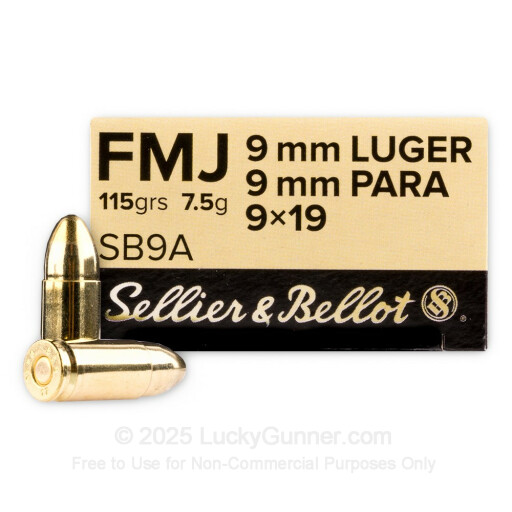





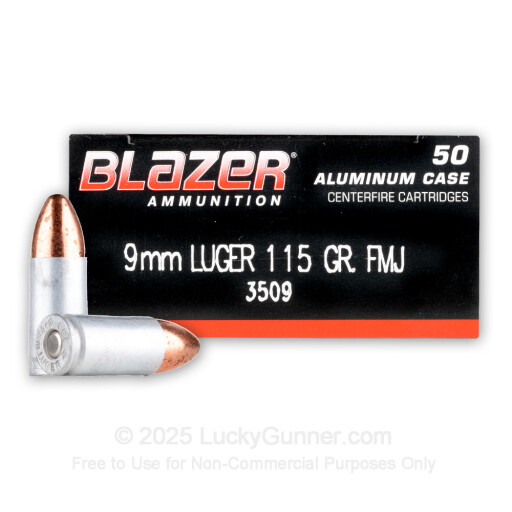
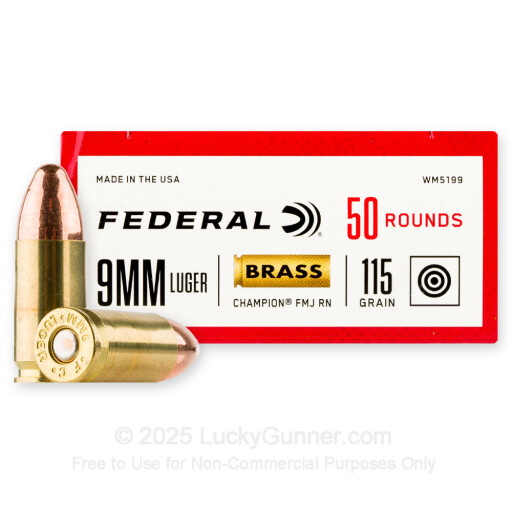







Modularity and Other Features
My original intention for this review was to compare the XL and the original P365. Then the lockdown thing happened and it wasn’t going to be practical for me to borrow the P365 like I had planned. But once I started shooting and carrying the XL, I also kind of lost interest in the other gun. This is such a good shooter and it’s been so easy to conceal that I’ve never felt the need for it to be smaller.
Even so, I should probably mention that, just like the Sig P320 series, the P365 has a serialized fire control unit. That means the part that legally counts as a firearm is inside the frame. So if you have a P365 XL, for about 40 or 50 bucks, you can pick up a standard P365 grip module. It takes about 30 seconds to swap the parts around and then you have the shorter grip with the longer XL slide. Of course, you also have to drop another 50 bucks for one of the smaller 10-round mags to go with it.
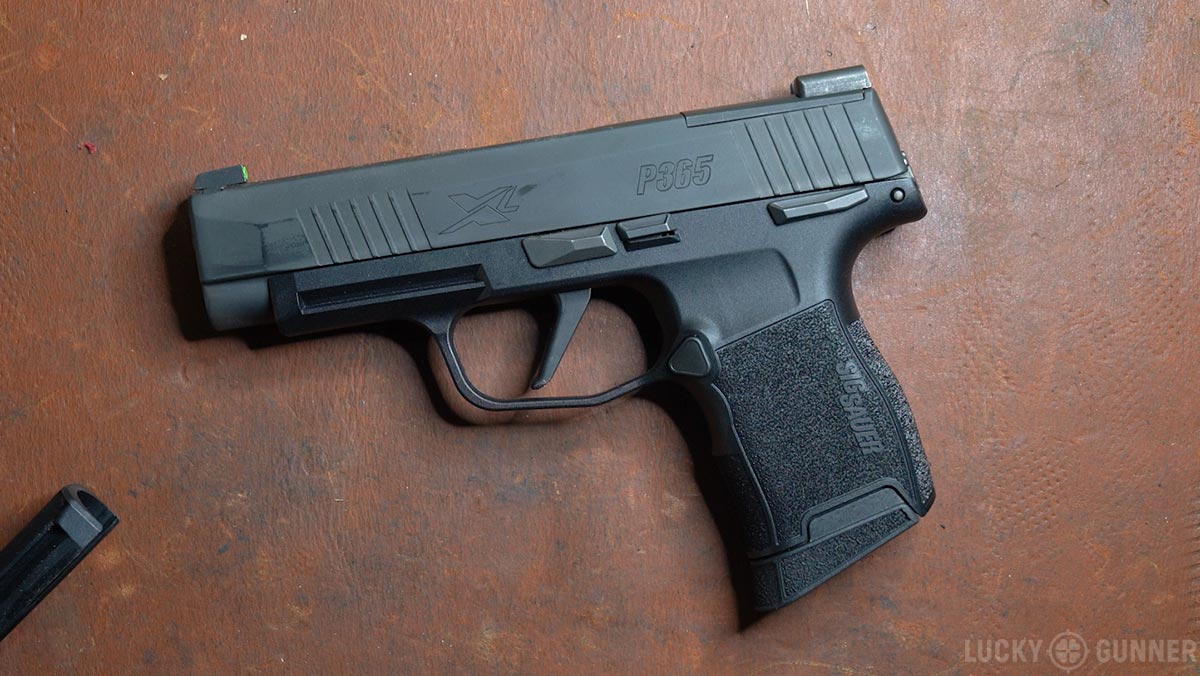
I’m pretty happy with the size of this gun as-is, though. And really, there’s not much in general I would want to change here, other than what I already mentioned about the safety. It would be nice if the texture on the grip extended all the way up to the slide so you could get a better grip with the support hand. So far, I can’t find much else that needs major improvement.
The trigger is nice right out of the box. It’s got some take up and then a smooth rolling break. It’s not crisp like a single action. This is actually what I prefer a trigger to feel like, though. I want there to be constant motion — constant tactile feedback as I’m putting pressure on the trigger so I know exactly when it’s going to break. I don’t like a trigger with an abrupt wall of resistance that just kind of stops until you press hard enough for it to break unless it’s a super light single action. This is a good carry trigger. I measured it at about 6 pounds on our trigger pull gauge but it doesn’t feel like 6 pounds. It’s a flat face trigger, so you can put more pressure toward the bottom of the trigger and that makes it feel lighter than it is.
The SIG X-RAY3 sights that come with the gun are also very nice and I almost never say that. For low light, they’ve got a three-dot tritium setup, but in normal light, the rear sight is basically black and the front sight has a highly visible neon green ring. If you don’t like that, of course you can just go with a red dot. There are two screws in the bottom of the slide. If you remove those, this plate and the rear sight come off so you can mount a micro red dot optic.
Factory optic cuts are gradually becoming more common on handguns, even smaller ones. I’ve decided to finally set aside some time this year to seriously train with a red dot optic on a pistol. I’ll be talking about that more sometime down the road. The Sig P365 XL slide is cut for the Sig ROMEOZERO optic, which shares a footprint with the Shield RMSc. It will also fit the soon to be released Holosun HS507K and the Swampfox Sentinel.
These are some of the smallest pistol optics on the market and I expect them to be super popular as more people add dots to their carry guns. I’ll be trying out a few of these and I’ll let you guys know when I think I can recommend one of them for serious use.
The Verdict
I can’t tell you whether I’ll end up carrying this gun long term. I’m always trying out different stuff and somehow I end up back at a snub nose revolver anyway, so I’m probably not the best example to follow. That said, this gun does everything I could ask a carry gun to do. It’s reliable. It’s easy to conceal and it’s comfortable to carry all day. I can shoot it just about as well as anything else I would ever consider carrying. It’s supported by all of my favorite holster-makers. I can shoot it for long practice sessions without it wearing me out. I wouldn’t hesitate to take it to a high round-count shooting class.
It’s a compromise gun that doesn’t really feel like much of a compromise. If you were to tell me that I had to choose, right now, just one pistol to be stuck with forever — that I could never carry or practice with any other handgun. Today at least, I think my answer would be the Sig P365 XL.
But they have got to do something about that safety.
